Do you have a question about the Fronius Wattpilot Go 11 J and is the answer not in the manual?
Explains danger, warning, and caution symbols.
Follow operating instructions for safe and proper use.
Covers qualified personnel and environmental criteria.
Addresses EMC, user data security, and manual copyright.
Describes the purpose and limitations of the Wattpilot.
Explains symbols on the device and rating plate.
Lists items included and optional accessories.
Describes symbols located on the front panel.
Covers dangers from incorrect operation, EMF, and housing damage.
Addresses risks associated with loose parts and damaged cables.
Warnings about damaged cables, wet connectors, and driving with cable attached.
Covers risks from gassing batteries and excessive load.
Precautions regarding heat, excessive charging current, and connection types.
Identifies main components of the Wattpilot.
Explains the card reader and pushbutton operations.
Explains ID chip use and lists standard current levels.
Describes reset card usage and LED status indicators.
Details LED patterns for starting, ready, enable, and waiting states.
Explains LED patterns for 1-phase and 3-phase charging.
Shows LEDs for charging finished, ID chip detected, and invalid input.
Details LED patterns for earthing test, communication faults, and residual current.
Explains LEDs for earth faults, missing phases, temperature, and updates.
Shows LEDs for successful and failed updates.
Explains LEDs when the reset card is detected.
General function of the Wattpilot and mode switching.
Automatic switching between phases and using solar energy.
Details power levels for 1-phase and 3-phase charging.
Illustrates PV surplus charging behavior.
Discusses minimum EV charging power and PV surplus.
Explains priority settings in systems with battery and Ohmpilot.
Details priority settings with inverter and battery.
How to use variable electricity tariffs.
Description of standard mode and its limitations.
How Eco Mode works with PV surplus and tariffs.
Illustrates Eco Mode charging scenarios.
How Next Trip Mode works for scheduled charging.
Details on setting up Next Trip Mode and related notes.
Example of planning a journey with Next Trip Mode.
Criteria for selecting location and required mounting orientation.
Step-by-step guide for mounting the device on a wall.
Important safety and general notes for connecting the device.
Specifics for installing the Home 11 J model.
How to use backup power mode and start the device.
How to stop charging and connect to the inverter.
Describes app features and how to download it.
Steps to connect to WLAN and add a Wattpilot.
Overview of the app's main charging screen and navigation.
How to view energy usage by registered ID chips.
Explanation of the data recorded for each charging session.
Adjusting current levels and configuring Next Trip Mode.
Options for tariff and PV surplus integration.
Setting limits for battery, Ohmpilot, and configuring PV surplus.
Customizing EV behavior and setting charging schedules.
Adjusting LED brightness, colors, and setting the time zone.
Configuring access control and cable locking modes.
Enabling/disabling earthing test and managing ID chips.
Procedures for registering and managing ID chips.
Setting a password for device security.
How to update the Wattpilot firmware.
Electrical and physical specifications for different models.
Environmental parameters for operation and storage.
Graph showing residual current detection behavior.
List of available spare parts and safety features.
Default settings for charging modes and current levels.
Default values for trip planning and cost optimisation.
Default parameters for PV surplus and vehicle selection.
Default settings for phase switching, charging timer, and brightness.
Default configurations for access management, earthing, and ID chips.
Explains codes for fault current and missing phases.
Details codes for grounding faults, relay issues, and backup power.
Covers codes for connector issues and internal communication errors.
Explains codes for high temperature, tariff data, and inverter connection issues.
Covers codes for Eco Mode activation and energy reachability.
Details codes for tariff update failures and vehicle detection issues.
Solutions for when no LEDs light up or brightness is zero.
Information on warranty terms and conditions.
Instructions for environmentally sound disposal.
Explains danger, warning, and caution symbols.
Follow operating instructions for safe and proper use.
Covers qualified personnel and environmental criteria.
Addresses EMC, user data security, and manual copyright.
Describes the purpose and limitations of the Wattpilot.
Explains symbols on the device and rating plate.
Lists items included and optional accessories.
Describes symbols located on the front panel.
Covers dangers from incorrect operation, EMF, and housing damage.
Addresses risks associated with loose parts and damaged cables.
Warnings about damaged cables, wet connectors, and driving with cable attached.
Covers risks from gassing batteries and excessive load.
Precautions regarding heat, excessive charging current, and connection types.
Identifies main components of the Wattpilot.
Explains the card reader and pushbutton operations.
Explains ID chip use and lists standard current levels.
Describes reset card usage and LED status indicators.
Details LED patterns for starting, ready, enable, and waiting states.
Explains LED patterns for 1-phase and 3-phase charging.
Shows LEDs for charging finished, ID chip detected, and invalid input.
Details LED patterns for earthing test, communication faults, and residual current.
Explains LEDs for earth faults, missing phases, temperature, and updates.
Shows LEDs for successful and failed updates.
Explains LEDs when the reset card is detected.
General function of the Wattpilot and mode switching.
Automatic switching between phases and using solar energy.
Details power levels for 1-phase and 3-phase charging.
Illustrates PV surplus charging behavior.
Discusses minimum EV charging power and PV surplus.
Explains priority settings in systems with battery and Ohmpilot.
Details priority settings with inverter and battery.
How to use variable electricity tariffs.
Description of standard mode and its limitations.
How Eco Mode works with PV surplus and tariffs.
Illustrates Eco Mode charging scenarios.
How Next Trip Mode works for scheduled charging.
Details on setting up Next Trip Mode and related notes.
Example of planning a journey with Next Trip Mode.
Criteria for selecting location and required mounting orientation.
Step-by-step guide for mounting the device on a wall.
Important safety and general notes for connecting the device.
Specifics for installing the Home 11 J model.
How to use backup power mode and start the device.
How to stop charging and connect to the inverter.
Describes app features and how to download it.
Steps to connect to WLAN and add a Wattpilot.
Overview of the app's main charging screen and navigation.
How to view energy usage by registered ID chips.
Explanation of the data recorded for each charging session.
Adjusting current levels and configuring Next Trip Mode.
Options for tariff and PV surplus integration.
Setting limits for battery, Ohmpilot, and configuring PV surplus.
Customizing EV behavior and setting charging schedules.
Adjusting LED brightness, colors, and setting the time zone.
Configuring access control and cable locking modes.
Enabling/disabling earthing test and managing ID chips.
Procedures for registering and managing ID chips.
Setting a password for device security.
How to update the Wattpilot firmware.
Electrical and physical specifications for different models.
Environmental parameters for operation and storage.
Graph showing residual current detection behavior.
List of available spare parts and safety features.
Default settings for charging modes and current levels.
Default values for trip planning and cost optimisation.
Default parameters for PV surplus and vehicle selection.
Default settings for phase switching, charging timer, and brightness.
Default configurations for access management, earthing, and ID chips.
Explains codes for fault current and missing phases.
Details codes for grounding faults, relay issues, and backup power.
Covers codes for connector issues and internal communication errors.
Explains codes for high temperature, tariff data, and inverter connection issues.
Covers codes for Eco Mode activation and energy reachability.
Details codes for tariff update failures and vehicle detection issues.
Solutions for when no LEDs light up or brightness is zero.
Information on warranty terms and conditions.
Instructions for environmentally sound disposal.
| Charging Power | 11 kW |
|---|---|
| Output Current | 16 A |
| Weight | 4.5 kg |
| Protection Class | IP54 |
| Phases | 1 |
| Amperage | 16 A |
| Charging Modes | Mode 2, Mode 3 |
| Operating Temperature | -25 °C to +50 °C |
| Input Voltage | 230 V |
| Output Voltage | 230 V |
| Connectivity | WiFi, Ethernet, Bluetooth |
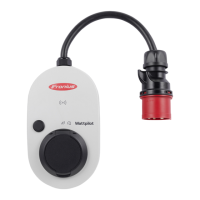
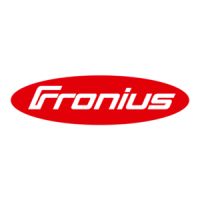
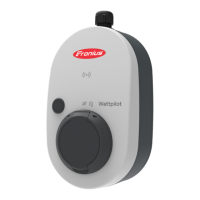



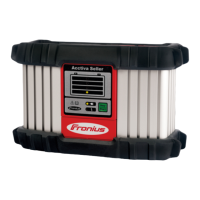

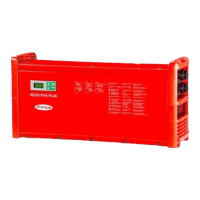

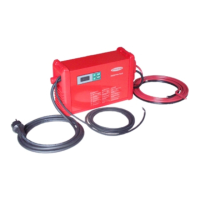
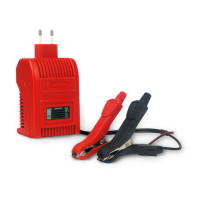
